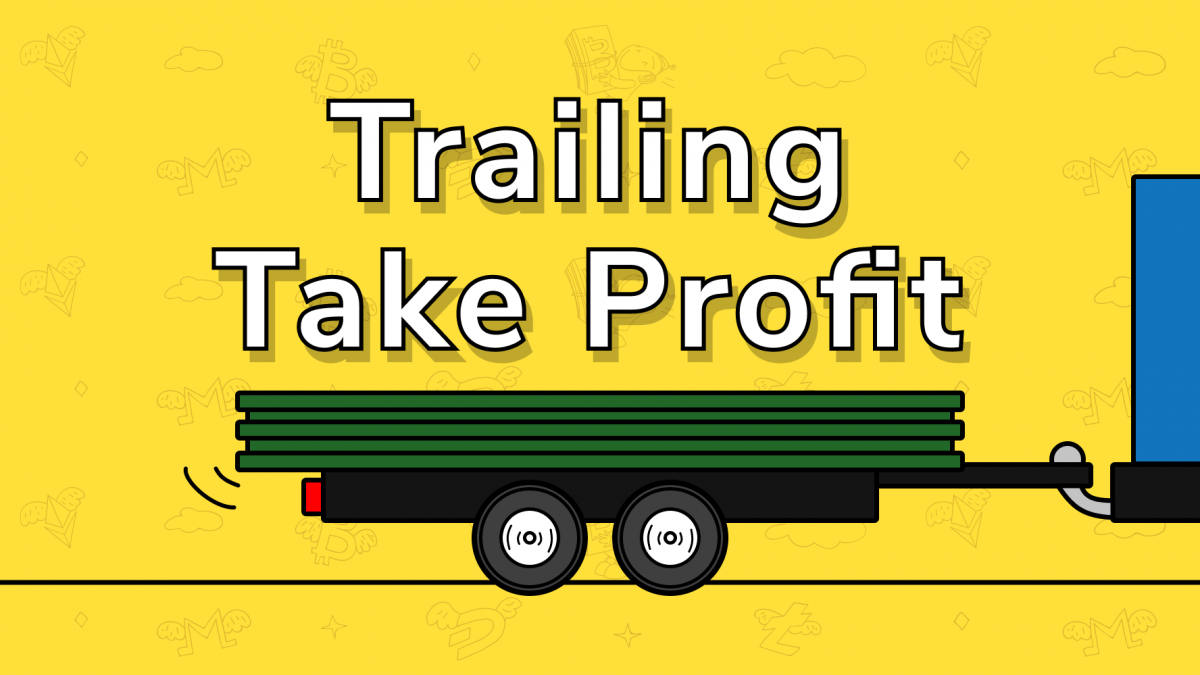Trailing Take Profit
Trailing Take Profit is used by the traders to increase their gains when the prices moves in a favorable direction. Let’s have a look at what is Trailing Take Profit and how it works.
What Is a Trailing Take Profit?
Trailing Take Profit is a term largely used in crypto, whereas you may encounter the term Trailing Stop in traditional trading describing almost the same thing, So what’s the difference between Trailing Take Profit and Trailing Stop? Trailing Stop is a type of Stop Loss automatically moving in the same direction as the asset’s price. Trailing Take Profit is nothing else than Trailing Stop activated after initial Take Profit is reached.
The main difference between these two is that Trailing Take Profit takes the profit in any case (although it might be later annihilated by Trailing Stop). Thus, Trailing Take Profit reduces the risks that might’ve occurred using Trailing Stop alone. Trailing Take Profit is bound to the maximum of Take Profit price instead of just a price increase/decrease.
As you might notice, the terms Trailing Take Profit and Stop Loss are quite similar. To avoid confusion, in this article we will be talking about Trailing Take Profit as defined above.
Trailing Take Profit only moves in one direction. It is designed to lock in profit and limit losses. The trailing profit only moves up (in case of a long strategy) once the price has surpassed previous high and a new high has been established. If the trailing take profit moves up, it cannot move back down, thus securing the profit and preventing losses.
Trailing Take Profit allows the trade to remain open and continue to profit as long as the price is moving in the investor’s favor. If the price changes direction and the change surpasses the previously set percentage the order will be closed.
How Does it Work?
For example if you buy BTC at the price of 10000, if you set a Take Profit at 11000 and a Trailing Take Profit at 5% :
If the price goes up to 10500, nothing happens because the Take Profit at 11000 has not been reached.
Then if the BTC price goes up top 11000, a Stop Order at 10450 will be set.
Then if the BTC price goes down to 10500, the Stop Order stays at 104500.
Then if the BTC price goes up to 12000, the Stop Order moves to 11400.
Then if the BTC price goes down to 11000, the Stop Order at 11400 is executed.
You see that without Trailing Take Profit, the buy order would have been sold at 11000. Thus, a trader would miss an earning opportunity at 11400.
The Risks of Trailing Take Profit
There are several rules to remember if you want to take advantage of Trailing Take Profit:
1)Don’t use Trailing Take Profit on coins with low liquidity (daily volume less than 100 BTC). You may end up losing money due to unpredictable price movements.
2)Avoid Trailing Take Profit for the coins with a wide spread between buy and sell. It may work not as you expected closing the deal earlier than needed.
3)Set Trailing Take Profit reasonably relative to the Take Profit Percentage. Establishing the idealing Trailing Take Profit distance is the hardest part. If you set Trailing Take Profit too tight, it will be triggered by the normal day market movements and the trade has little room to move and you may end up losing the gains you could’ve earned. If you set Trailing Take Profit too wide you’re risking to give up more profit than it was needed.
4)If you want to catch a price movement and expect the price to return to its previous level, consider using Take Profit instead of Trailing Take Profit option, Trailing Take Profit is used best
Trailing Take Profit is an effective tool in a traders arsenal. Keep in mind the risks of Trailing Take profit and test different approaches with Virtual bots to find the best approach for your trading style.
FAQ
What are Trailing Stops & Trailing Buys?
A trailing buy order is good to go long because it follows the asset’s price as it goes down. The order gets triggered as soon as the trend reverts, and the price rises from its low by the trailing distance you’ve set. That allows you to not only buy at a lower price, but also to do that exactly when the price stops falling and starts rising, maximizing your chances to make a profit.
Trailing Stop order can be used to both enter and exit a position. When you enter a position with a Trailing Stop order, you’d refer to it as a Trailing Buy (if you establish a Long position) or a Trailing Sell (if you go Short). When you exit your position with a Trailing Stop, you’d refer to it as a Trailing Stop Loss or Trailing Take Profit. In fact, when Trailing Stop order is used to exit a position it possesses qualities of both Stop Loss and Take Profit at the same time.
